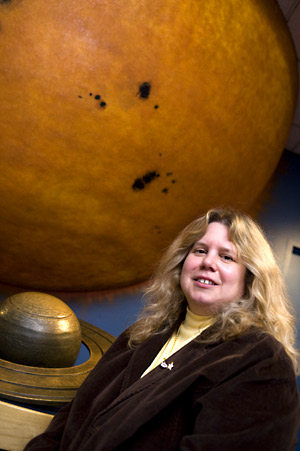“Seeing” Stars
Astronomer Noreen Grice Promises the Moon, the Sun, and the Stars to the Visually Impaired
| From Alumni Notes | By Cynthia K. Buccini
 Noreen Grice (CAS’85) is the founder and president of You Can Do Astronomy LLC, a design and consulting business that makes space science accessible to the disabled. Photo by Vernon Doucette
Noreen Grice (CAS’85) is the founder and president of You Can Do Astronomy LLC, a design and consulting business that makes space science accessible to the disabled. Photo by Vernon Doucette
As an astronomy major in 1984, Noreen Grice was working at the Boston Museum of Science’s Charles Hayden Planetarium when a group of blind visitors arrived for a show about the stars. She took their tickets, helped them to their seats, dimmed the lights, and started the prerecorded program.
“It wasn’t very descriptive,” says Grice (CAS’85), now an astronomer and the planetarium’s operations coordinator. “During the show, I was looking at the group and wondering what they thought. So at the end of the program, I asked them how they liked the show. They said they thought it stunk and walked away.”
Grice wasn’t put off by their honesty. Instead, she took a bus to the Perkins School for the Blind in Watertown, studied the astronomy books in its library —they were in Braille but had no pictures —and came up with an idea: create an illustrated astronomy book for the blind.
More than twenty years later, Grice is the author of five such books, with two more in the works, and is an expert in making astronomy and space science accessible to the disabled. Her books feature both text and color illustrations in print and in Braille. Touch the Sun, for example, renders the sun as a yellow and orange circle filled with raised ripples that represent the gas currents on its surface.
The books are meant to be read by the sighted and the visually impaired alike. “What I’m trying to do is to create materials that are useful for both populations, so there isn’t so much of ‘theirs,’ but more of ‘ours.’” Grice says.
Her initial efforts at making touchable images, back in 1984 with advisor Ken Janes, a College of Arts and Sciences professor of astronomy, were admittedly crude. “We’d try shellacking Play-Doh —all kinds of things,” Grice says. After putting the project aside —she earned a master’s at San Diego State University and later returned to the Museum of Science —Grice found a more high-tech solution. Using a Braille embosser, she began creating tactile images to accompany the planetarium shows; once the shows were accessible, she decided to revisit the book.
It took about a year to complete Touch the Stars. National Braille Press translated the words, and Grice created images of the Big Dipper, the Ring Nebula, Orion the Hunter, and other astronomical objects on a computer, which she then printed on heavy paper using the embosser. The museum published the first edition in 1990; all 400 sold out within a year. Touch the Stars, published by National Braille Press, is now in its fourth edition.
More books followed: Touch the Universe: A NASA Braille Book of Astronomy (2002), which includes embossed color images that were taken by the Hubble Telescope, Touch the Sun (2005), The Little Moon Phase Book (2005), and Touch the Invisible Sky (2007). “I’m just working my way through the universe,” Grice says.
“I get lots of e-mails from kids who are blind and want to become astronomers. I’m trying to encourage them to think of possibilities,” she says. “A lot of kids have said they’re going to be the first blind astronaut to walk on Mars. And I believe it’s going to happen.”

 Twitter
Twitter Facebook
Facebook
Post Your Comment